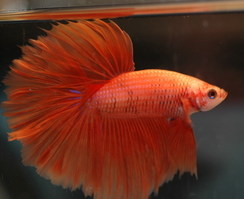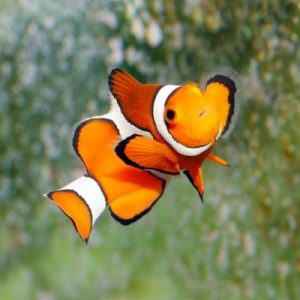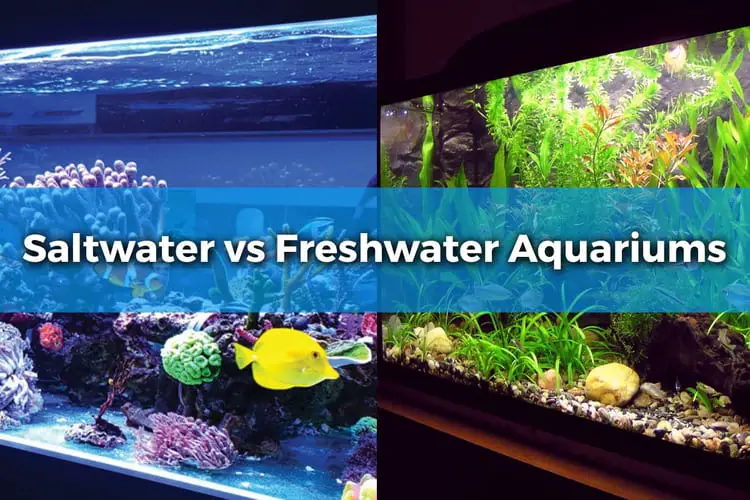There are many fish, plants, corals, and invertebrates available for saltwater and freshwater aquariums! So much so that deciding which kind of fish tank to start next can be a real challenge!
Saltwater ecosystems are full of brilliantly colored fish, exotic crustaceans, and corals that grow like living stone. Contrast that to freshwater environments with fish that are just as beautiful, subdued yet fascinating invertebrates, and plants as verdant as any jungle.
Both types of aquariums have a lot to offer in terms of interest and beautiful inhabitants. So which type of aquarium is right for your next home tank?
Choosing Between Saltwater vs Freshwater Fish Tanks
Spoiler alert: there is no right answer for every aquarist! Saltwater and freshwater aquariums both have a lot to offer. Some folks will prefer one or the other, and that’s entirely fine.
This guide is for beginners who want to know about the differences to make an informed choice!
To help you decide between going with a saltwater vs freshwater aquarium, we’re going to discuss what goes into setting up both options.
Our discussion topics include:
- Which is the most beginner-friendly
- Available Animals and Plants
- Overall Ease of Care
- Equipment Needs
- Aquarium Maintenance
- Maintenance Costs
Saltwater vs Freshwater Tanks: Which is Right for Beginners
Both freshwater and saltwater tanks have advantages to offer the beginning aquarist. I’d say freshwater environments are slightly easier to manage because less water chemistry monitoring is involved.
This is important for the saltwater aquarium because many saltwater fish species tend to be highly sensitive to sudden water parameter changes.
A freshwater environment tends to shift much more often and more quickly than the ocean. A sudden rain, flood, or storm that knocks a load of vegetation into the water can cause drastic shifts in salinity, pH, and other parameters.
Meanwhile, the ocean hardly changes except through slow seasonal shifts. Therefore freshwater fish are better adapted to change.
This sensitivity to change makes small saltwater nano coral reef tanks more challenging compared to tanks for freshwater plants and fish. A smaller fish tank will shift in parameters much faster than a larger one if you, say, overfeed by mistake.
And the ultrapure water required by many corals makes them difficult to get experience with at first. That said, there are plenty of saltwater fish and even corals that are hardy, inexpensive, and beginner-friendly. Just fewer compared to the freshwater ones!
Planning Your Aquarium
When planning new aquariums, you’ll need to decide which fish, invertebrates, plants, and animals are going in them. And for these inhabitants, you’ll need the right filtration system, lighting, protein skimmer, and other equipment that needs to be set up.
There are many similar aspects to freshwater and saltwater aquariums in this regard. All animals need oxygen, clean water, and some level of heating. Freshwater or saltwater plants (macroalgae) also need carbon dioxide and other nutrients.
Let’s talk about what to choose for your tank!
Available Fish, Invertebrates, Flora & Fauna
Beginner Friendly Freshwater Fish & Plants:
- Betta Fish
- Kuhli Loaches
- Cichlids
- Danios
- Plecos
- Corydoras
- Cherry Barbs
- Amano Shrimp
- Most Rosette Plants (Cryptocoryne, Amazon Swords, etc.)

The list of challenging freshwater fish is shorter than that for saltwater tanks because so many freshwater fish are captive-bred. But there are a few that are either solely wild-caught or just innately sensitive.
Challenging Freshwater Fish & Plants:
- Discus
- Stingrays
- Arowanas
- Dwarf Shrimp
- Most Carpeting Plants (Dwarf Baby Tears, Monte Carlo, etc.)
Despite the differences in chemistry in saltwater and freshwater tanks, there are still a number of tough, inexpensive saltwater fish that a beginner can start with.
One advantage is that even beginner saltwater fish species tend to be much more brightly colored compared to any freshwater one.
Also, more and more saltwater fish are captive bred these days. This means they tend to be easy to feed and are resistant to more unstable water conditions than wild fish.
Beginner Friendly Saltwater Fish, Plants & Corals:
- Damselfish
- Clownfish (Optional: They Love Bubble Tip Anemone!)
- Molly
- Pygmy Angelfish
- Dwarf Lionfish
- Royal Gramma
- Lawnmower Blenny
- Yellow Tang
- Pulsing Xenia, Green Star Polyp, Toadstool Leather Corals
- Macroalgae

Still, it’s also true that saltwater aquarium fish tend to be both more expensive and harder to keep. Sensitive marine species make even difficult freshwater aquarium fish look easy.
Challenging Saltwater Fish & Corals:
- Large Angelfish
- Surgeonfish
- Ribbon Eels
- Sharks
- Most Hard Corals
Choosing Your Equipment
Some equipment you will buy no matter what you set up. Both freshwater and saltwater species need a filtration system to keep the water quality high. Of course, you do need salt to enter the saltwater world. Any reef aquarium requires a protein skimmer as well.
The specific types of equipment you buy will also affect how much money you spend. So make sure you’re aware of the upfront costs at the start!
For saltwater setups, a fish-only tank is an easier starting point than reef tanks. There is much less to know, set up, and purchase if you’re only keeping fish! Live rock is still convenient even if you don’t have any corals, though.
How Aquarium Size Matters
A new aquarist is likely to think that the bigger the aquarium, the harder it is to maintain. In truth, it’s actually the reverse! The more water you have, the more pollution it takes to foul it.
If you overfeed in a large aquarium, it’s going to have much less impact compared to overfeeding in a nano tank. It does take more time to do water changes, but you’ll likely do smaller ones in proportion to the volume of the tank.
As mentioned before, if you’re interested in a smaller fish tank, then freshwater aquariums are right for you. Freshwater fish weather shifts in water chemistry better than saltwater ones.
But that doesn’t mean that you can be lax with water changes and other maintenance tasks. Goldfish can, according to the Tropical Fish Care Guide, live for decades in ideal conditions. Too few make it that long.
This sensitivity to water conditions in the saltwater environment makes larger tanks better choices for beginners. Aquariums 30 gallons or larger make great starting points.
Aquarium Cleaning and Maintenance
Since freshwater aquariums and saltwater aquariums both require a mature filtration system, maintenance is mostly going to come down to things like algae and your animal and plant species’ needs.
Algae growth is often harder to control in a saltwater tank or reef aquarium because there are fewer to no live plants available for hobbyists to choose from. There are hundreds of different plants in a freshwater environment that provide shade and competition to algae for lights and nutrients.
Reef tank corals do absorb some nutrients that algae would use. But not nearly as fast as plants do. Fortunately, there are plenty of algae-eating crabs, snails, and fish that can help keep saltwater tanks free of algae.
Aquarium lighting is also important to consider for your tank. A freshwater aquarium with live plants will need similarly intense light as a reef tank full of corals and sea anemones.
That said, low light plants are more efficient at competing with algae than low light corals. High-light aquariums require extra carbon dioxide for freshwater plant inhabitants – or very low nutrient levels for reef tanks to avoid algae growth.
Certain species of fish may need extra additives to adjust the water chemistry. This is common in freshwater environments where the pH can range from 4.0-9.0. The ocean is generally at 7.9-8.5, so saltwater tanks tend to need less adjustment once established.
Both kinds of aquarium need regular water changes to remove excess waste like nitrates and detritus. Typically, you’ll use a gravel vacuum to pull debris out from within the substrate.
Your Guide to Tank Size Requirements
As a rough rule of thumb, 10-20 gallons is a great size to start with for your first freshwater aquarium. However, 20-30 gallons is better for your first saltwater tank. This is because saltwater holds less oxygen than freshwater, which reduces the number of fish that can live within.
And as I explained earlier, saltwater tanks need more water volume to remain stable enough for the fish and other animals to survive. Freshwater aquariums and fish can handle more flux in their ecosystem.
If you want to keep something as simple as a betta fish, you can even go with a tank as small as 5 gallons. But nano saltwater aquariums this small definitely aren’t for beginners.
Here are some minimum tank size requirements to consider when setting up a freshwater or saltwater tank!
Aquarium Size | Fish Length | Habitat | Ease of Care | |
Betta Fish | 5 gallons | 2-3 inches | Freshwater | Easy |
Tetra | 10 gallons | 2 inches | Freshwater | Easy |
Clownfish | 10 gallons | 2-3 inches | Saltwater | Easy |
Flame Angelfish | 20 gallons | 3 inches | Saltwater | Medium |
Pearl Gourami | 20 gallons | 3-4 inches | Freshwater | Easy |
Mandarin Goby | 20 gallons | 3 inches | Saltwater | Difficult |
Discus | 40 gallons | 6 inches | Freshwater | Difficult |
Yellow Tang | 40 gallons | 5 inches | Saltwater | Easy |
Oscar | 55 gallons | 10 inches | Freshwater | Easy |
Lionfish | 75 gallons | 12 inches | Saltwater | Easy |
Necessary Equipment
When setting up any fish tank, you’ll need to buy several pieces of equipment. Here are the purchases that are most common for new aquarists to make.
Freshwater Aquarium Equipment Checklist
Freshwater tanks contain everything a saltwater tank will. The only real difference is that there are many more coldwater fish available for freshwater compared to saltwater. When keeping coldwater fish, you can forgo the heater.
Freshwater Aquarium Checklist:
- Aquarium
- Filtration System & Media
- Heater
- Substrate (typically Gravel or Sand)
- Test Kit(s)
- Fish Food
- Lighting
- Net
- Pump or Powerhead (for current)
- Air Pump + Air Stone
- Maintenance Tools (Gravel Vacuum, Glass Scraper, etc.)
- Decorations (Driftwood, Fake or Live Plants, Rocks, etc.)
Saltwater Aquarium Equipment Checklist
The saltwater aquarium list has a few differences from the freshwater one. But both types have supplies you’ll find in any pet store!
Saltwater Aquarium Checklist:
- Aquarium
- Filtration & Media
- Heater
- Substrate (typically Aragonite Gravel or Sand)
- Test Kit(s)
- Sea Salt + Hydrometer
- Saltwater Fish Food
- Lighting
- Protein Skimmer
- Net
- Powerhead (for current)
- Air Pump + Air Stone
- Maintenance Tools (Gravel Vacuum, Glass Scraper, etc.)
- Decorations (Live Rock, Corals, etc.)
Saltwater vs Freshwater: Which One Costs More?
Saltwater aquariums do cost more; there’s no getting around it. Even the most advanced freshwater aquariums don’t have to use protein skimmers and don’t have salt as a constant expense.
But if you’re in love with the color and activities of saltwater fish then there’s really no other option but to jump in!
| Freshwater Aquarium | Saltwater Aquarium | |
| Glass Aquarium | $50 | $50 |
| Power Filter | $40 | $40 |
| Heater | $20 | $20 |
| Lighting | $50 | $50 |
| Salt | Not needed. | $25 |
| Protein Skimmer | Not needed. | $100+ |
| Water Test Kits | $25 | $50 |
| Live Rock | Not needed. | $100 |
| Substrate | $20 | $45 |
| Aeration | $20 | $20 |
| Total | $225 | $500 |
Annual Maintenance Costs

Just because you have everything you need to start the aquarium doesn’t mean you won’t have any future expenses. There are several maintenance costs that are monthly or yearly expenses over time.
For a freshwater tank, you have food, aquarium water test kits, and water conditioners (de-chlorinator, pH adjusters, plant fertilizers, medications). These will likely run you between $150-200 per year, depending on what’s living in your tank.
Any saltwater aquarium needs all of the above plus salt. Many corals also have their own supplemental needs. But salt is quite inexpensive, so the annual maintenance costs are comparable vs freshwater tanks!
Deciding Which System Is Right For You
Let me first say that there is no final one size fits all answer here. Which system is right depends entirely on your needs, budget, desires, and available space.
Here are some questions to consider that will help you decide which system is right for you!
- How many fish do I want to keep?
- Are there certain fish I really love above others?
- What tank size do the types of fish I want need?
- Am I comfortable regularly checking the water parameters to maintain a highly stable environment?
- What kind of aquascape do I prefer? Coral and live rock or plants and driftwood?
- Do I want a wavemaker?
- Do I fully understand the maintenance involved in keeping a saltwater or freshwater tank?
- Do I have the budget for more expensive fish or only inexpensive fish?
- Do I want to try corals and other reef tank invertebrates?
- Are live plants something I like?
Be aware that there’s no getting around the fact that a little more does go into saltwater aquarium setups in terms of time and expense.
You’ll spend more time testing the water, adding supplements, and paying more for the tests, supplements, and fish. But not as much as you might think. And if you really love saltwater fish, then it’s entirely worth the extra fuss!
Choose a Freshwater Tank If:
You are concerned about maintaining stable water chemistry over an extended period. Many fish for a freshwater tank can handle parameter swings that would kill even hardy saltwater fish.
A freshwater tank is also a good choice for budget-minded people. Marine setups cost more for salt, extra test kits, the substrate, a protein skimmer, and often the animals. Freshwater fish are almost always cheaper and hardier.
Choose a Saltwater Tank If:
You are confident in your ability to maintain a stable ecosystem. A saltwater aquarium is sensitive to fluctuations vs freshwater aquariums, but stability is 9/10ths of the battle.
If you can handle that, then there are plenty of fish, corals, and invertebrates that are just as easy as freshwater fish. And many are far more colorful, especially shrimp and corals!
Frequently Asked Questions:

